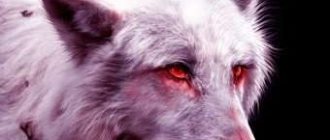Transmission of the virus from humans
According to numerous studies, infection from an infected person is practically impossible. This fact is due to the virus content in saliva. Rabies is not transmitted through the air, blood, or simple contact.
To become infected, the patient must not only attack and bite, but also damage the upper layer of the epidermis.
Transmission is also possible when saliva comes into contact with damaged human skin. Science knows of a single case of infection during a cornea transplant from an infected person to a healthy patient.
Rabies is caused in warm-blooded animals by a virus that enters the body when bitten by a sick animal.
In practice, such cases are rare. For this reason, it is believed that interaction with sick people does not pose an epidemiological danger. A similar situation is with pets that have been in contact with sick people. A pet can become infected from a person only in the event of a bite with drooling.
Under natural conditions, the virus is not persistent and dies within half an hour.
How not to get infected
There are a number of situations in which the risk of transmitting the virus is minimized.
Rabies cannot be transmitted if:
- penetration of salivary fluid of an infected person onto intact skin;
- scratching with bird claws;
- eating food from an infected animal after heat treatment;
- bite from a vaccinated pet.
biting the skin without damaging the skin using protected clothing;
People and animals who have been in contact with the infected person are vaccinated
It is important that the vaccination period is no more than 1 year, and there are no signs of the disease. In such a situation, the pet is monitored. If signs of the disease appear, the victim is vaccinated. The risk of infection is also reduced by bites in non-hazardous areas.
In medical circles, the manic fear of rabies is called lysophobia.
Epizootological data
The disease is characterized by viral carriage before the appearance of obvious clinical signs, lasting about 10 days after infection. Based on this fact, domestic animals suspected of having bitten a person are kept in quarantine for 10 days under observation. If during quarantine the animal did not show symptoms of rabies, then there was no virus in its saliva at the time of the bite.
Susceptibility to the disease depends on the type of animal, location of the bite, dose and strain of the virus. The most dangerous area for bites is the area of the head, rich in nerve fibers. The virus is transmitted orally through bites containing saliva. Infection is also possible if infected saliva gets on the mucous membranes or the surface of open wounds when saliva from an infected animal comes into contact with them. This fact underlies oral rabies vaccination of wild carnivores. Such vaccines include food baits that are attractive to animals, inside of which there is an inactivated vaccine in a foil capsule; the animal bites the bait, damages the oral mucosa with the sharp edges of the capsule, thus the virus enters the body and causes the formation of an immune response.
In nature, there is a strict cyclical nature of disease outbreaks (2-3, less often 3-4 years), which appear with an increase in the number of red foxes. The disease is seasonal in nature, associated with the biology of wild carnivores. The first rise is early spring (fox rut), the second is autumn-winter (dispersal of young animals through the forest).
Dog incubation period
Rabies is a viral disease associated with inflammation of the brain.
The incubation period of the disease directly depends on:
- size of the infected person;
- location and depth of the bite;
- the health status of the bitten person.
The smaller the animal, the faster signs of rabies appear.
In children, the disease develops in a shorter period of time compared to adults. The development of the virus occurs faster in the case of damage to the neck, face, and head. Accordingly, when extremities are bitten, the incubation period increases.
The incubation period for human infection is up to 3 months. Wounds in the head area significantly accelerate the development of the disease. Cases have been recorded where symptoms appeared within a week after the attack. If the extremities are affected, the virus may not manifest itself for up to 1 year. There have been cases where the disease entered the active stage after 2-3 years.
At the moment, it is known that the virus remains dormant for 6 years. It was recorded in an emigrant who arrived in America from the Philippines.
The incubation period can be short (several days), but it can be quite long - several months
In animals, the timing of the development of the disease differs slightly from that in humans. The incubation period ranges from 10 to 21 days. With shallow lesions and good immunity of adults, symptoms appear after 5-9 months.
Rabies is a virus for which treatment is powerless.
Only relief of the patient's condition is possible. The disease is transmitted when the epidermis is injured and salivary fluid penetrates the surface of the wound. In other cases, the likelihood of spread is minimal. Professional help and vaccination can prevent the development of the disease.
Symptoms of rabies infection
After infection in the initial period, body temperature may rise and pupils may dilate. The animal's excitement gradually increases, irritability, photophobia, trembling, and lack of coordination of movements appear. In some cases, diarrhea occurs. As the disease progresses, the animal may become aggressive and may lunge and bite other animals and people. Or vice versa, many wild animals (especially foxes) lose their fear of people, they often approach populated areas, become affectionate, and try to lick them. Further, as the disease progresses, paralysis appears, including in the jaws, and convulsions, which leads to the death of the animal.
Unfortunately, there is currently no effective treatment for rabies. If you suspect that your pet has been attacked by a rabid animal, you must take it as quickly as possible to the state animal disease control station (SASD), which is located in every district or administrative center. If you have been bitten or licked by a stray domestic or wild animal, you must immediately contact a trauma center for rabies treatment.
The only effective method of preventing rabies is timely vaccination of animals. Safe and effective vaccines have been developed for use in veterinary medicine. Most vaccines recommend vaccinating dogs and cats from 12 weeks (3 months) of age. In areas affected by rabies, vaccination of dogs and cats from 8 weeks of age (2 months) is allowed. Then the animals are vaccinated once a year.
We remind dog and cat owners of the need to annually vaccinate their pets against this dangerous disease!
Myths about rabies: how you can and cannot get infected
Over the past 2 decades, the number of cases of referrals to infectious disease specialists with phobias associated with the fear of contracting rabies has increased significantly. Panic often conjures up the most incredible ways. However, there are clear criteria that determine the risks of the disease.
Rabies - why is everyone afraid of it?
Everyone knows that rabies is a terrible disease that cannot be treated, and can be contracted through the bite of a sick animal. Most often, the source of the virus is foxes, less often dogs, cats, hedgehogs, bats, horses, birds and other animals that contain the pathogen in their saliva. There is no cure for the disease and the outcome is always fatal. Every year, cases of rabies are recorded in different areas. How does a person become infected with rabies?
- when bitten by a sick animal;
- when saliva gets on mucous membranes or damaged skin.
In this case, it is necessary that the wound has damaged the skin until it bleeds. The only way to protect against the disease is vaccination. In case of even minimal risk, you need to go to the emergency room as early as possible.
Symptoms and signs of infection
The typical form includes the stage of initial manifestations with headaches, nausea, vomiting, and pain at the site of the bite. Then aggression, fear of hydrophobia, convulsions and spasms appear. After this, the patient dies from cardiac or respiratory arrest.
There are atypical forms that occur without paralysis and hydrophobia; patients are quiet and apathetic. In children, all stages usually pass in 3–5 days, i.e. the duration of illness is shortened.
When and how to get vaccinated against rabies
There are special rules establishing the rules for vaccination. Vaccinations are given in the following cases:
- compression when biting open areas of the skin, minor scratches or abrasions without bleeding;
- one or more bites that penetrate the skin or scratches;
- licking damaged skin;
- wounds caused by birds' beaks;
- damage to the skin by claws;
- contamination of mucous membranes with saliva.
In all cases, except the first, a special immunoglobulin is first introduced, then a course of vaccinations begins.
For vaccination, vaccines of different names, but identical in composition, are used, usually “KOKAV”. The standard regimen is used, injections are given on days 1, 3, 7, 14, 30 and 90 from treatment. Sometimes changes may be made at the discretion of the doctor. During the vaccination period, you should not drink alcohol-containing liquids - they reduce the immune defense against rabies, increase the likelihood of allergies, and put a strain on the liver. A sick animal dies in a short time - up to 10 days. For a person, this period varies depending on the location of the bite - the closer it is to the head, the faster the death occurs.
If the bitten animal is domestic and does not look suspicious, and its owner claims that it has been vaccinated, then it will be monitored for 10 days. In the event of his sudden death, they begin a course of vaccinations; if everything is fine with the pet, then vaccination is not required, because he is healthy. If vaccination has begun and the animal is alive after 10 days, the course of vaccination can be interrupted. According to WHO, vaccination is not necessary in the following cases:
- touching an animal or feeding it;
- animals licking intact skin;
- contact of intact skin with secretions of rabid animals or humans.
How can you tell if a dog has rabies?
Absolutely every owner should know how rabies manifests itself in dogs. As a rule, such an infectious disease most often occurs in a violent form, which is divided into the following stages:
- Prodromal
– lasts a day or three. During this period, the animal may yawn frequently, breathe through its mouth, swallowing air. Salivation often increases slightly. Some dogs become drowsy and apathetic, others behave calmly and affectionately. At this stage, it is, unfortunately, very difficult to determine the disease; - Manic
– lasts from two to five days. The dog begins to act strangely: growl at the owner, avoid the inhabitants of the house, be affectionate beyond measure. A creature that was calm a second ago can quickly attack its owner. In moments of rest, the animal continually strives for a secluded corner. The pet begins to be afraid of water. The more strongly the virus affects the body, the more noticeable the symptoms of rabies in a dog are: increased salivation, convulsions, heavy breathing; - Paralytic
is the last stage, which means that the end will come very soon. Lasts two to three days. The dog does not eat or drink, saliva flows from its mouth almost continuously. There is no more anger, the animal simply lies indifferently, periodically shaken by convulsions. Muscle paralysis gradually develops, leading to death from respiratory arrest.
Rabies can also occur in a silent form, although much less frequently compared to violent ones. With this course of the disease, the animal experiences the following symptoms:
- A good appetite;
- Adequate behavior;
- Difficulty swallowing saliva, water and food;
- Salivation;
- Problems with gait;
- Rapid paralysis of the limbs and larynx.
In its silent form, the disease takes away the animal’s strength suddenly, in just 2-4 days.
If yesterday the dog felt fine, then today he may die. In addition, although rare, rabies can occur in remitting (symptoms of the disease either subside or increase) and atypical (there are no obvious symptoms of rabies, but there are signs of intestinal infection) forms.
What is rabies in dogs and why is it dangerous?
Rabies has a long history and a “strong association” with dogs. The first written account of rabies is contained in the Laws of Eshnunna, dated 1930 BC. e. The report contains not only a diagnosis, but also recommendations that the owner of a dog exhibiting symptoms of rabies should take all possible measures to prevent it from biting anyone.
What is rabies in dogs? It is a viral neuroinvasive disease that causes inflammation in the brain and is usually fatal. Rabies is viral in nature and primarily affects mammals.
During laboratory research, it was discovered that birds can also be infected with the virus. A minor risk group includes cold-blooded animals and insects; they become infected with the virus only unnaturally, if a person has a hand in this process.
Animals with rabies suffer from deterioration of the central nervous system and tend to behave strangely and often aggressively. Inappropriate behavior increases the likelihood that a virus carrier will bite a healthy animal or person, which will lead to transmission of the virus.
In dogs, rabies usually develops in three stages:
- Prodromal or first stage 1–3 days – characterized by behavioral changes.
- The second stage, 3–4 days , is characterized by excitement. It is this stage that is associated with "rabid animal rage" due to the affected dog's tendency to become hyper-reactive to external stimuli and bite anyone and anything that comes close.
- The third stage of 2–3 days is the paralytic stage, which is caused by damage to the neurons of the brain. There are coordination problems and other problems in the central nervous system. The dog cannot walk or does so unnaturally due to paralysis of the hind limb. At this stage, foamy drooling is observed. Further, there are difficulties with swallowing, paralysis of the facial and throat muscles. Death usually occurs due to collapse of the respiratory tract.
Note! Most people become infected with rabies from canines and wild animals. Among domestic animals, the most common carrier of the virus is the dog.
Diagnosis and treatment of rabies in domestic animals
If rabies is suspected, the animal is isolated and quarantined. For 10 days, specialists monitor his behavior. A dog or cat can live from 2-4 days to two weeks (from the moment the first signs of the disease appear).
Are examinations and laboratory tests performed on animals with rabies?
Unfortunately, there is no point in holding such events. While the animal is in quarantine, it may or may not show clear symptoms of the disease. If the diagnosis is confirmed, he is euthanized. There is no cure for the disease; euthanasia is carried out in order to stop the suffering.
Laboratory tests are performed posthumously (to document the diagnosis). This is a required practice.
Incubation period after rabies infection
In the process of large-scale research, it was found that the rabies virus enters the bloodstream through the bite of a virus carrier. The virus spreads from the site of the bite to the brain. Virus cells travel both in the bloodstream and along nerve fibers.
Important! Until the virus concentration in the brain reaches a critical mass and neuronal damage begins, the animal does not appear sick.
The incubation period is the time between the bite and the onset of symptoms. Incubation of the rabies virus can last from several weeks to several months. An animal bite during the incubation period does not carry the risk of infection, since the virus has not yet entered the saliva. At the final stage of the disease, the sick dog produces saliva with a huge amount of virus.
How does infection occur?
Animal rabies is a viral disease characterized by severe damage to the peripheral nervous system and signs of disseminated encephalomyelitis. The disease will inevitably lead to death. Refers to natural focal, periodic viral diseases. All types of warm-blooded, domestic and agricultural animals (cattle, horses, sheep, pigs), as well as most species of birds and humans are susceptible to infection.
The disease is provoked by an RNA-containing bullet-shaped virus of the family. Rhabdoviridae (rhabdoviruses). There are four serotypes of the pathogen that are widely distributed in the environment. The rabies virus is resistant to external environmental factors, some chemical disinfectants, and low temperatures. Under favorable conditions, it can persist in animal corpses from several months to several years. Kills instantly at a temperature of 100 degrees. UV rays inactivate it within 5–12 minutes.
recommended articles:
- What are the reasons for the death of rabbits?
- What is the normal temperature for pigs?
Having penetrated the body of animals, the rabies virus is initially localized in the salivary glands and lymph nodes, after which it penetrates through the bloodstream into other organs, in particular the spinal cord and brain (horns of Ammon, cerebellum), causing irreversible changes in the functioning of the central nervous system.
The reservoir of a dangerous virus in the natural environment is wild animals: wolves, foxes, jackals, raccoons, arctic foxes, raccoon dogs, bats, rodents (voles, rats), hedgehogs, and other types of domestic carnivores. The localization of natural foci of infection corresponds to the characteristics of the distribution of wild animals, which are prone to long-distance migrations.
Wild carnivores are reservoirs of the rabies virus in the natural environment
Taking into account the nature of the reservoir of the rabies pathogen, epizootics of this infection are distinguished between urban and natural types. Within the city limits, the infection is spread by stray cats, dogs, and latent virus carriers.
Important! Cases of animal rabies infection are currently being recorded in all countries of the world, including in the regions of our state.
Infection of the rabies virus in agricultural and domestic animals occurs through direct contact with an infected individual. Rabies virus It is transmitted through a bite. The pathogen enters the body through damaged mucous membranes and skin. Infection of animals with a deadly infection is possible through aerogenic (airborne) and nutritional routes.
The rabies virus is released into the external environment mainly through saliva, discharge from the nose, and eyes.
Animal rabies is characterized by periodicity and seasonality. Most often, outbreaks of rabies of this disease are recorded in autumn, early spring, and also in winter. The risk group includes unvaccinated animals, weakened, emaciated individuals, and young animals kept in unfavorable conditions.
Rabies virus
Ways of infection with rabies
Routes of infection contacts. All species of mammals are susceptible to infection with the rabies virus, but only a few species in specific areas are the leading vectors.
In Europe and Asia, the most common carriers of the rabies virus are:
- Foxes.
- Bats (predatory).
- Jerzy.
- Raccoons and other canids.
Transmission of the rabies virus occurs when a carrier's infected saliva is transferred to an uninfected animal. The most common way of transmitting the rabies virus is through a bite.
Possible routes of infection are:
- Scratches.
- Contact of contaminated saliva or blood and damaged mucous membranes.
- Contact of contaminated saliva or blood and damaged skin.
Note! recent studies have shown that an animal can become infected with rabies by inhaling gases that are released when the corpse of a virus carrier decomposes. It is unknown whether a person can become infected with rabies in a similar way.
From dog to dog
The rabies virus is transmitted from dog to dog by:
- Bites during fights.
- Courtship - contact of infected saliva with damaged mucous membranes.
The second route of transmission is extremely rare. The fact is that at the moment when the virus accumulates in saliva, the dog develops phobias to sounds, water, light and tactile contacts.
From dog to man
The rabies virus is transmitted from dogs to humans by:
- Bites.
- Contact of saliva and damaged skin or mucous membranes.
In the second case, we are talking about a form of rabies in which the primary symptoms are similar to gastritis or enteritis. During the treatment of the diagnosis, which is assumed based on the anamnesis, the owner is constantly in contact with contaminated saliva.
From dog to cat
The rabies virus is transmitted from dog to cat by:
- Bites.
- Scratches.
- Contact of blood and mucous membranes.
In the second case, the virus enters the body of a healthy dog in small quantities. In the external environment, the rabies virus survives for 24 hours, and cats are known to clean their claws with their teeth and tongue.
In the third case, the dog may come into contact with the cat's blood if it responded to the attack. During the bite process, infected blood enters the mucous membranes of the dog's mouth.
Transmission of rabies from animals
Wild and domestic animals become frequent carriers of rabies. In the dangerous group: foxes, wolves, hedgehogs, rodents, dogs, cats, sheep, goats, cows, pigs. Animals can get rabies in spring, summer and autumn. The peak occurs in the spring and summer. Rabies manifests itself differently in animals and humans and has certain stages of development. In both cases, the disease develops rapidly, the incubation period is several days. Infected animals are characterized by:
- Disease incubation period. Duration reaches ten days. The animal becomes restless, loses appetite, and chews hard objects.
- The second period is difficult (violent). Aggression towards humans and other animals appears, profuse salivation begins, and fear of water begins. Extreme levels of infection by the virus lead to paralysis and death.
In cats, the disease can occur in several stages, when the animal becomes aggressive or, conversely, quiet, affectionate and apathetic. When the virus enters the human body, it causes severe inflammation. As the virus multiplies, it quickly attacks healthy cells and tissues, which leads to internal bleeding, swelling, convulsions, and paralysis.











